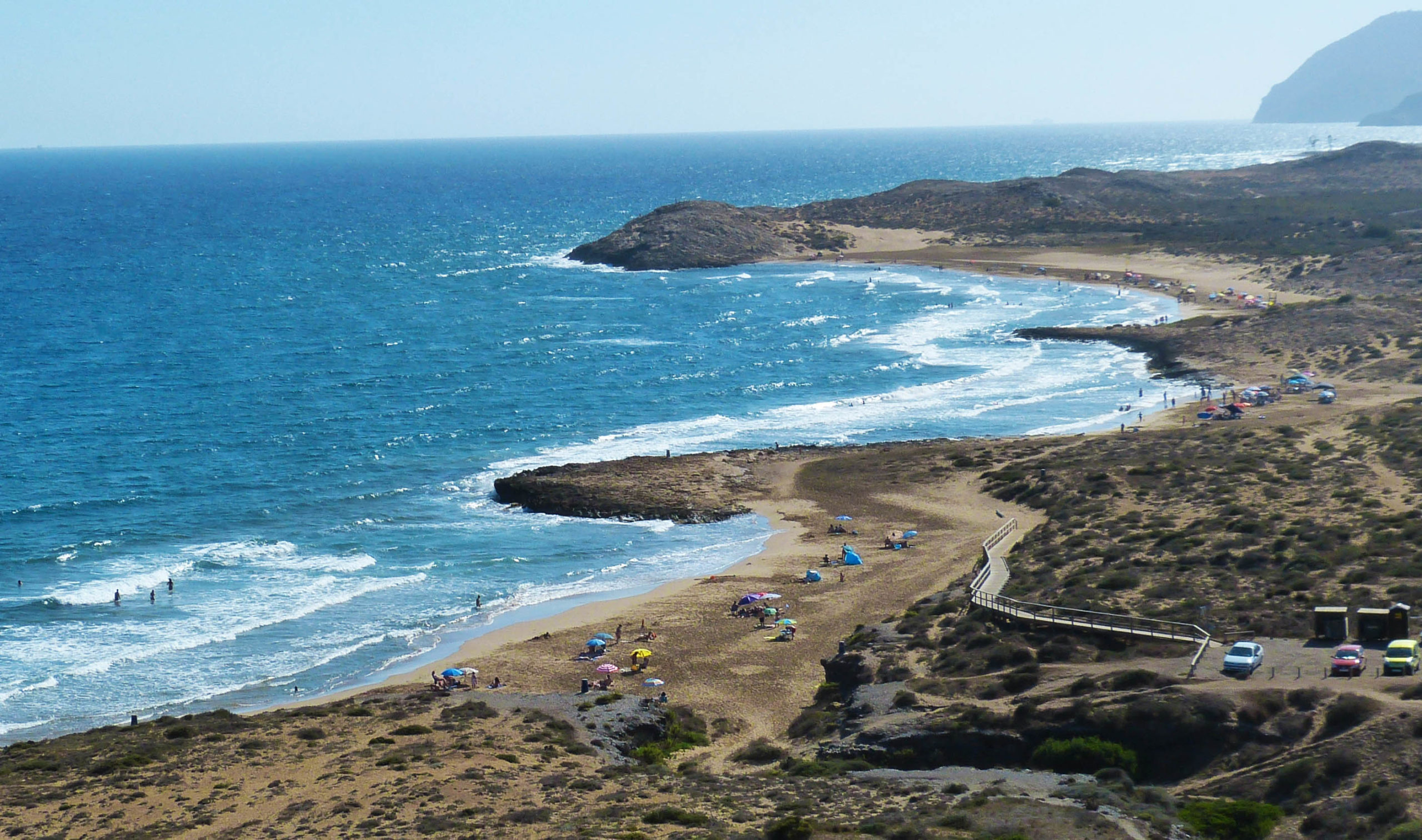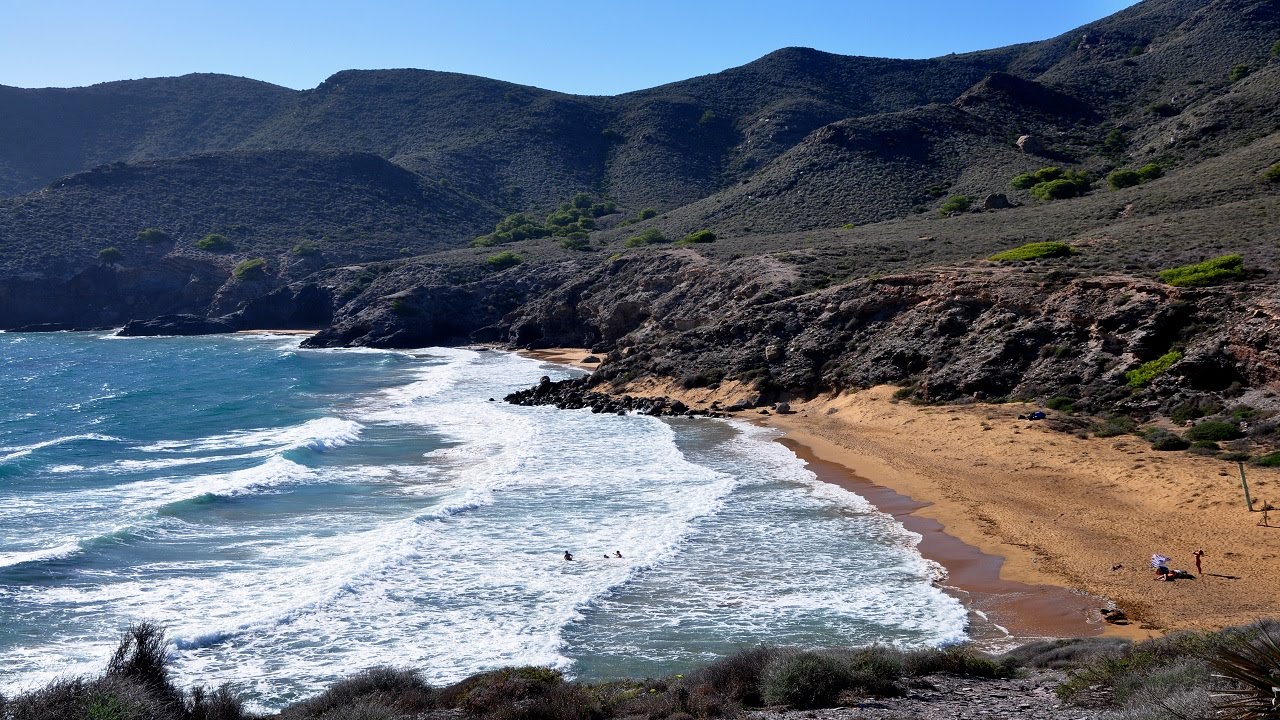Calblanque / Spain – Windsurf – Murcia – Cartagena – La Manga del Mar Menor

 Surfergalaxy
Surfergalaxy 
| Wave | |
| Ola | |
| Wind | |
| Tide | All |
| Marea | Todas |
| Swell | ENE, SSW |
| Bottom | Sand |
| Fondo | Arena |
| Time of year | From October to May |
| Época del año | De octubre a mayo |
Calblanque is south orientated and so has more exposure to the W wind, in fact, it rarely works with Levante (E, but when there is groundswell and the Levante doesn’t have too much of a North component, it can work. It normally needs strong stormy Poniente (W) to make it good for jumping and waveriding. With the strong winter Poniente, the waves can reach more than two metres. You’re likely to require a 4,7 or 5,3 sail. With Poniente, Calblanque has a strong current and the waves break with a lot of force. To sail here you’ll need a good level, above all because of the rocks on both sides of the shore.
Calblanque está orientado al Sur y más expuesto al viento del Oeste, de hecho, es raro que funcione con levante (Este, pero cuando hay mar de fondo y el levante no está demasiado anortado, Calblanque puede funcionar también bien. Normalmente para que funcione tiene que ser poniente fuerte de borrasca, que entra bastante limpio, bueno para saltar y surfear, Las olas llegan a más de los dos metros en ponientes fuertes de invierno (Viento para 4.7-5.3). Con poniente en Calblanque la corriente es fuerte y las olas rompen con mucha fuerza. Se necesita cierto nivel, sobretodo porque puedes acabar en las rocas que hay a ambos lados de la orilla.
One of the best waves in La Manga can be found at a beach that’s located at the end of a track in the Calblanque Nature Reserve. In the winter the low pressure can help to create big mast high waves with the Poniente (W) wind. The strong currents and rocks on both sides of the small shoreline make it a spot for experienced windsurfers as if you underestimate the conditions here, you could end up on the rocks. Remember it’s a protected area so respect the place and the access road. There are many other nearby spots in La Manga to choose from, such as Cabo de Palos, Playa de Levante, Hotel Cavanna and Ciervo Island.
Una de las mejores olas de La Manga del Mar Menor se encuentra en una playa situada al final del camino en la Calblanque Nature Reserve. En invierno con las bajas presiones puede haber olas grandes de poniente que pueden llegar a la altura del mástil. Las fuertes corrientes y las rocas a ambos lados de la pequeña orilla hacen que sea un lugar para experimentados, si se subestiman las condiciones puede acabarse en las rocas. Se navega con vientos de W o SW. Hay que tener en cuenta que es una zona protegida, por tanto, hay que respetar el lugar y los caminos de acceso. En La Manga del Mar Menor los spot se encuentran cercanos unos de otros y hay muchos donde elegir. Cabo de Palos, Playa de Levante, Hotel Cavanna e Isla del ciervo están próximos a Calblanque.

Las Amoladeras village in Cabo de Palos, is an area of interest which dates back to the Neolithic times. There you can see traces of Greek walls from Cala del Pino, visit the Cabo de Palos lighthouse which was built in 1865, and also the Faro del Estacio. You could also visit the wetlands Las Salinas and Arenales in San Pedro del Pinatar, from where you’ll be able to watch incredible sunsets mixed with the nature and diverse migratory birds.
A very good option away from the water is the route from Cala Reona in Cabo de Palos to Calblanque on foot or bike. The exquisite trail has many deep wells along the way, a variety of vegetation including aromatic plants, beaches that are free from buildings, and it’s surrounded by mountains. There is a market every Sunday near to the port in Cabo de Palos and numerous restaurants along the promenade offering views of the Mediterranean Sea. The cities of Cartagena and Murcia are 40 and 56 kilometres away respectively.
El poblado de Las Amoladeras ubicado en Cabo de Palos, es una zona de interés turístico que data del Neolítico, donde podrás contemplar restos de murallas griegas desde la Cala del Pino, ver el Faro de Cabo de Palos construido en 1865 y también el Faro del Estacio. Por otro lado, puedes visitar Las Salinas y Arenales de San Pedro del Pinatar, unos humedales donde poder observar increíbles atardeceres mezclados con la naturaleza y diversidad de aves migratorias.
Una ruta a pie o en bicicleta desde Cala Reona, en Cabo de Palos, hasta Calblanque tiene alto atractivo. El sendero está lleno de pozos de gran profundidad, la diversidad vegetal se compone de plantas aromáticas y las playas sin edificaciones y rodeadas de montañas componen un paisaje de gran belleza. En Cabo de Palos los domingos hay un mercadillo muy variado cerca del puerto y a lo largo del paseo encontrarás numerosos restaurantes con vistas al mediterráneo. La ciudad de Cartagena se encuentra a 40 kilómetros y Murcia a 56 kilómetros.